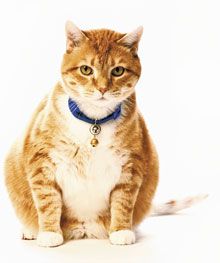Pet obesity research reveals more than half of U.S. dogs and cats remain overweight
Survey also identifies 'fat gap': Nearly all owners of overweight pets do not recognize excess weight.

Getty ImagesData collected in 2014 by the Association for Pet Obesity Prevention (APOP) found that 58 percent of U.S. cats and 53 percent of dogs were overweight. This presents a problem not only for more than half of the country's pets, but for the profession's efforts to educate clients about the health hazards associated with excess weight and to gain client compliance to manage that weight.
The past three years of APOP's National Pet Obesity Prevalence Survey show that the percentage of overweight pets is unchanged. However, of pets classified as overweight, the number that qualifies as clinically obese continues to grow-from 17 percent of dogs in 2013 to 18 percent in 2014, and 27 percent of cats in 2013 to 28 percent in 2014.
Furthermore, the data found that a "fat gap" persists in the minds of veterinary clients. Nearly all owners of overweight cats and dogs did not recognize their pets' excess weight. That discrepancy increased in 2014-90 percent of owners of overweight cats and 95 percent of owners of overweight dogs identified their pets as having a normal weight. In 2013, those percentages were 88 percent (cat owners) and 93 percent (dog owners).

Client handout: Get your pet moving
Share how regular exercise and better nutrition habits can be fun for pets and pet owners alike with advice from Dr. Ernie Ward.
“The sad truth is that most people can't identify an obese dog or cat," says Steve Budsberg, DVM, BS, MS, DACVS, veterinary orthopedic specialist and director of clinical research for the College of Veterinary Medicine at the University of Georgia. "Whenever their veterinarian tells them their pet needs to lose weight, they often can't believe it because they don't see it.”
Excess weight and even obesity is obviously difficult for pet owners to recognize-and it may be even more difficult to accept when a veterinarian suggests that a pet needs to lose weight. “No one wants to think their pet is overweight, and overcoming denial is our first battle,” Ward says.
He says clients need to know-early on, not once a pet is obese-the importance of maintaining a healthy weight. Adhering to a veterinarian's recommended nutritional philosophy may be more appealing as a preventive measure when they understand what it takes to treat diseases like diabetes and arthritis. "There are real consequences for ignoring this," Ward says.
Ward contends that only 50 percent of pet owners say their veterinarian has talked to them about nutritional issues, but 75 percent say it would be extremely helpful. "Veterinarians think they don't want to hear it-they do. If we don't talk about it, they get it at the pet store," he says. "We're losing the conversation war."
Click here for a handout that gives pet owners tools to manage weight through exercise and nutrition. To learn more about the Association for Pet Obesity Prevention or the 2014 study, go to petobesityprevention.org.